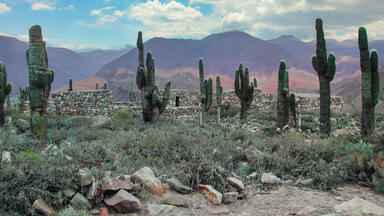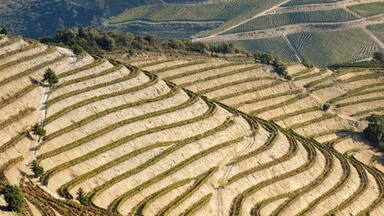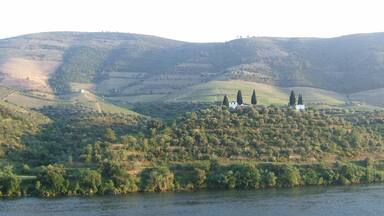Alto Douro Wine Region
Alto Douro Wine Region
Wine has been produced by traditional landholders in the Alto Douro region for some 2,000 years. Since the 18th century, its main product, port wine, has been world famous for its quality. This long tradition of viticulture has produced a cultural landscape of outstanding beauty that reflects its technological, social and economic evolution.
Description is available under license CC-BY-SA IGO 3.0
Région viticole du Haut-Douro
Le Haut-Douro produit du vin depuis quelque deux mille ans et sa principale production, le vin de Porto, est célèbre dans le monde entier depuis le XVIIIe siècle. Cette longue tradition a façonné un paysage culturel d'une beauté exceptionnelle qui reflète en même temps son évolution technique, sociale et économique. Ce paysage culturel impressionnant est toujours exploité avec profit par des propriétaires respectueux des traditions.
Description is available under license CC-BY-SA IGO 3.0
منطقة الكروم في دورو العليا
تنتج منطقة دورو العليا النبيذ منذ ألفي سنة، ويشتهر نبيذ بورتو الذي يشكل منتوجها الرئيس في العالم بأسره منذ القرن الثامن عشر. وقد أدى هذا التقليد الطويل الأمد الى صياغة منظر ثقافي مدهش يتسم بجمال فريد ويعكس في الوقت نفسه تطوره التقني والاجتماعي والاقتصادي، كما انه لا يزال موضوع استغلال مربح لدى مالكين حريصين على التقاليد.
source: UNESCO/CPE
Description is available under license CC-BY-SA IGO 3.0
葡萄酒产区上杜罗
在葡萄酒的产区上杜罗,当地人酿酒的历史可以追溯到大约2000多年前。从公元18世纪开始,当地生产的葡萄酒就以质量好而世界闻名。长期的葡萄种植传统使得当地具有了独特的文化景致,展示着上杜罗的技术、社会及经济进步和发展。
source: UNESCO/CPE
Description is available under license CC-BY-SA IGO 3.0
Винодельческий район Алту-Дору
В районе Алту-Дору вино производилось традиционными методами на протяжении 2 тыс. лет. Начиная с XVIII в. его главный продукт – портвейн – приобретает, благодаря своему качеству, всемирную известность. Такие давние традиции виноделия сформировали культурный ландшафт выдающейся красоты, который отражает технологическую, социальную и экономическую эволюцию.
source: UNESCO/CPE
Description is available under license CC-BY-SA IGO 3.0
Región vitícola del Alto Duero
La vitivinicultura es una actividad tradicional de los agricultores del Alto Duero desde hace dos mil años y, entre los vinos de la región, destaca el oporto, célebre en el mundo entero desde el siglo XVIII. La larga tradición vitivinícola ha configurado un paisaje cultural de extraordinaria belleza, fiel reflejo de la evolución técnica, social y económica de la región. Los viñedos siguen siendo explotados por agricultores que respetan las técnicas de cultivo tradicionales.
source: UNESCO/CPE
Description is available under license CC-BY-SA IGO 3.0
アルト・ドウロ・ワイン生産地域
アルト・ドウロ地域では、2000年も前から昔ながらの方法でワインが醸造されてきた。その文化的景観には、ワイン生産に関連するあらゆる施設や村落、教会、道路などを含んでおり、ヨーロッパの伝統的なワイン生産地であることを顕著に示している。長年培われてきたブドウ栽培法は、各時代の技術や社会、さらに経済発展をも反映して洗練度を増し、ここで産出されるポートワインは18世紀以来、品質の良さで世界中で著名となっている。source: NFUAJ
Wijngebied Alto Douro
De traditionele grondbezitters in de Alto Douro regio produceren al ongeveer 2.000 jaar wijn. Sinds de 18e eeuw is port(wijn) – het hoofdproduct van de regio – wereldberoemd vanwege zijn kwaliteit. De lange traditie van wijnbouw heeft een cultuurlandschap voortgebracht van buitengewone schoonheid, dat zijn technologische, sociale en economische ontwikkeling weerspiegelt. De teelaarde moet door dammen op zijn plaats gehouden worden op de steile hellingen. Het meest kenmerkend voor het landschap van Alto Douro zijn de wijngaardterrassen. Ze zijn door de eeuwen heen met verschillende technieken aangelegd, rij op rij. De huidige terrassen dateren uit de 19e eeuw.
Source: unesco.nl
Outstanding Universal Value
Brief Synthesis
The river Douro and its principal tributaries, the Varosa, Corgo, Távora, Torto, and Pinhão, form the backbone of the mountain landscape, which is protected from the harsh Atlantic winds by the Marão and Montemuro mountains, has been transformed by steeply sloping terraced vineyards that cover some 24,600 ha.
Wine has been produced by traditional landholders in the Alto Douro Region for some 2,000 years. A world commodity, Port wine, a wine of a quality defined and regulated since 1756 is produced here.
Throughout the centuries, row upon row of terraces have been built according to different techniques. The earliest, employed during the pre-phylloxera era (pre-1860), was that of the socalcos, narrow and irregular terraces buttressed by walls of schistous stone, which require continuous maintenance on which only one or two rows of vines could be planted. The long lines of continuous, regularly shaped terraces date from the end of the 19th century and the beginning of the 20th century when the Douro vineyards were rebuilt, following the phylloxera attack. The new terraces altered the landscape, not only because of the monumental walls that were built but also owing to the fact that they were wider and slightly sloping to ensure that the vines would be better exposed to the sun.
Along the lower banks of the Douro or on the edges of watercourses on the hillsides are groves of orange trees, sometimes walled. The landscape is covered with brushwood and scrub and, here and there, a coppice of trees alternating with vineyards. Water used to be collected in catchments along stone channels. Characteristically white-walled villages and casais are usually located midway up the valley sides. Around an often imposing 18th century parish church, rows of houses opening directly on to the street to form a web of narrow, twisty roads with some notable examples of vernacular architecture. The Douro quintas are major landmarks, easily identified by the groups of farm buildings and wineries that around the main house particularly in the Upper Corgo and the Upper Douro. The landscape is dotted with small chapels located high on the hills or next to manor houses.
The long tradition has produced a cultural landscape of outstanding beauty that is at the same time a reflection of its technological, social, and economic evolution. The visually dramatic landscape is still profitably farmed in traditional ways by traditional landholders.
Criterion (iii): The Alto Douro Region has been producing wine for nearly two thousand years and its landscape has been moulded by human activities.
Criterion (iv): The components of the Alto Douro landscape are representative of the full range of activities associated with winemaking – terraces, quintas (wine-producing farm complexes), villages, chapels, and roads.
Criterion (v): The cultural landscape of the Alto Douro is an outstanding example of a traditional European wine-producing region, reflecting the evolution of this human activity over time.
Since the 18th century, its main product, Port wine, has been world famous for its quality. This long tradition of viticulture has produced a cultural landscape of outstanding beauty that reflects its technological, social and economic evolution.
Integrity
The boundaries fully encompass all the attributes of the Outstanding Universal Value.
The cultural landscape of the Alto Douro Wine Region is an outstanding example of humankind’s unique relationship with the natural environment. Its nature is determined by wise management of limited land and water resources on extremely steep slopes. It is the outcome of permanent and intense observation, of local testing, and of the profound knowledge of how to adapt the culture of the vine to such extremely unfavourable conditions. The landscape is an expression of people’s courage and determination, of their acumen and creative genius in understanding the cycle of the water and the materials, and of their intense, and almost passionate, attachment to the vine. The setting, in the landscape of several forms of training the vines, is an outstanding example of human ability to master physical constraints, here actually creating the soil and building an immense and extensive construct of buttressed socalcos. It is this acumen that enabled a multitude of anonymous artists to create a collective work of land art.
This landscape, however, is a whole and it is in constant evolution, now with new terrace-forms reflecting the availability of new technology. It is a diverse mosaic of crops, groves, watercourses, settlements, and agricultural buildings, arranged as quintas (large estates) or casais (small landholdings).
The general state of preservation of this historic landscape is good. Alterations do exist, but they do not seem of sufficient importance to impair its integrity. Some terraces suffered badly during torrential rain in the latter part of January 2001, and a special effort will be needed to restore parts of vineyards to working order.
Authenticity
Conservation as a "heritage concept" has scarcely been carried out in this area until recently. With everything subordinate to wine-growing, functional need has driven maintenance. As a result, the state of conservation of the Alto Douro Wine Region, in particular of the majority of supporting walls, is remarkably good, and clearly superior to that of the buffer zone. There, although a considerable amount of land under vine in quintas and casais and considerable vernacular heritage exist, the settlements in particular have suffered the loss of much of their original character.
Today they maintain the landscape’s active social role in perpetuating a prosperous and sustainable economy. Popular identification with the Region is reinforced by the congruence between its area now and that of the original demarcation.
The Alto Douro Wine Region has, and undoubtedly always had, a different meaning according to the perspective of each interest group. It is not looked at in the same manner by the parishioner who lives in the middle of the vineyard that has shaped his horizon since birth and which provides his sole source of income, or by the man from the mountain who remembers the days when the roga joyfully descended the hills to the Terra Quente to spend a few weeks working for the vintage. The Douro equally belongs to the small shopkeepers and middlemen in the region, to the owners of the quintas – both Portuguese and foreign – who stay there at different times in the year, to the shippers in the Douro and in Vila Nova de Gaia who are engaged in the wine trade, and to all those people in Portugal and the world over who have learnt to celebrate each great moment in their lives or in the destiny of nations with a glass of Port wine.
Yet the man-made landscape of so many significances is visibly there, a series of impressive views but also a seriously complex machine, still working.
Protection and management requirements
The existing legal provisions to ensure the protection of the property and its buffer zone are adequate.
Protecting and managing the Alto Douro Wine Region (ADWR) is a rather complex task considering the property’s size, the diversity of entities involved and the high number of owners and stakeholders.
Protection and management rules applying to the ADWR derive from the Intermunicipal Spatial Plan for the ADWR (IMSP-ADWR). Municipalities, stakeholders and different Government officials have been cooperating in the management and protection of the ADWR. The main concerns with the protection and management of the ADWR have to do with physical indicators such as: conserving and rehabilitating schistous stone walls and socalcos; adequating methods for installing vineyards and other cultures; creating arboreal networks for dividing vine fields and creating passageways; minimizing visual intrusions; recording, and protecting vernacular heritage; licensing of new buildings; enhancing settlements; implementing new road networks.
Associations have been set up with the aim of promoting and raising awareness for the protection and management of the property.
Long term vulnerabilities and challenges have to do with the application of strategic and guideline rules from the IMSP-ADWR, implementation of its action plan, dissemination of good intervention practices on vineyards, and liaison with all parties involved for the implementation of the common goal of protecting and managing the landscape.
The Management Plan (the IMSP-ADWR, approved in 2003 – RCM n.º 150/2003) is being revised to better adapt it to current needs and to link it to municipal development plans and planning tools.
A managerial structure – the Douro Mission (Estrutura de Missão do Douro) – was created in 2006. Its main objectives are the enhancement, preservation and safeguarding of the Alto Douro Wine Region landscape.
As experience has shown the large buffer zone of 225,400 ha is difficult to manage, there is a need for the Management Plan to address this issue.
For this purpose, the State Party has approved legislative adjustments to incorporate the safeguarding and promotion of the property within the tasks and duties of the North Regional Coordination and Development Commission, nominating as Site Manager the President of this Institution, supported by two advisory bodies, the Permanent Coordinating Group and Advisory Committee and an operational technical team, responsible for the implementation of the Monitoring Plan, another key element of the Management system.



